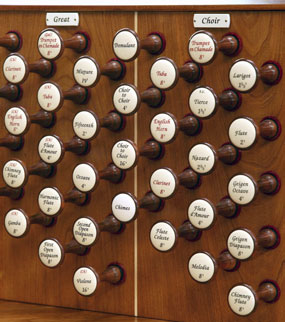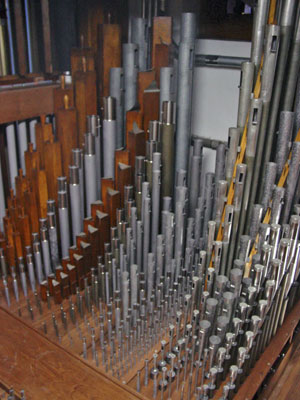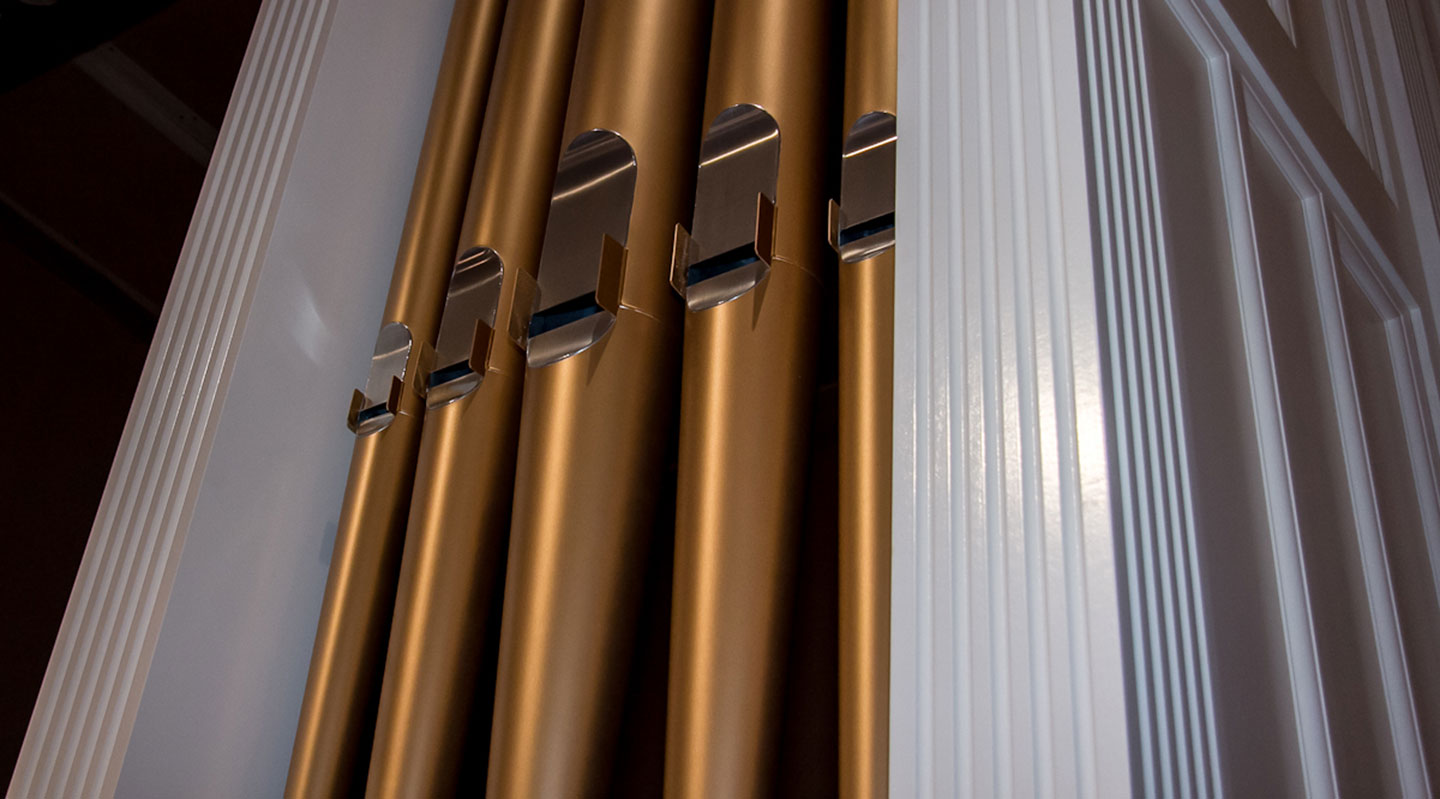Flute Stops
In the world of pipe organs, there are a many different kinds of flutes. For example there are Spitz Flutes, Block Flutes, Doppel Flutes, Gross Flutes, Orchestral Flutes, Harmonic Flutes, Concert Flutes, Traverse Flutes, Clarabel Flutes, Chimney Flutes, Flute D’ Amour, Triangle Flute, Rohr Flute, Koppel Flute, Flute a Bois, Stopped Flute, Open Flute, Wald Flute, and Fern Flutes; not to mention all the other typical members of the stopped family like, Bourdons, Gedeckts, Lieblichs, and other higher pitched ranks like Flautinos and Piccolos.
The reason there are so many is that all stops in an organ belong to specific families, such as principals, flutes, strings, and reeds. Some stops are intended to be used to build up a chorus. These stops are not really intended to be used as solo stops but rather in conjunction with other stops to build up a rich ensemble of sound. Some stops can provide color and interesting musical textures when used with other sounds. Careful use of flute stops in combination with strings or other flute stops can add melodic interest and can provide spice to many basic sounds. For example the simple addition of a colorful flute to a Salicional (String family), can add new life to a musical phrase.

For use in solo melodies, some flutes can be specifically voiced to be imitative, resembling the sounds found in an orchestra. These stops, which can be made of metal or wood, are found in either stopped or open variety. They can speak the note of their length (as found in open pipes), or emphasize the harmonic of the note (as is the case with harmonic flutes). Harmonic Flutes are pipes that have a small hole drilled at a point approximately halfway along the upper body of the pipe. This hole creates a node that emphasizes the natural octave sounding harmonic of the pipe. Constructed of metal and cylindrical in shape, these stops are commonly found at 4′ pitch, but can also be found at 8′ pitch. Other harmonic stops are Traverse Flute, often made of wood, Flute Octavian, Concert Flute, Orchestral Flute, and Zauberflute, that can be either harmonic or stopped.
Stopped flutes, (Bourdon, Gedeckt, Lieblich Gedeckt, Stopped Diapason, Flute d’ Amour) can be made of wood or metal. The stopper is inserted into the top of the pipe and forces the air column to return down the length of the pipe to create a distance twice as long as the physical length of the pipe. This in effect will also emphasize certain partial internal harmonics that help create character or color within the pipe. A Chimney Flute, also called RohrFlute, is a cylindrical pipe fitted with a movable cap that acts like a stopper. A small tube or Chimney is inserted into the cap that helps to emphasize the fifth sounding harmonic giving the stop a distinctive character.
Physical features that contribute to creating the flute tone are the voicer’s use of larger scaling with a smaller relative mouth width and a higher cut-up. Regulation of wind at the toe and usually heavy nicking of the flue decreases any harmonic color and increases the darker flute tone. All these elements, skillfully executed, contribute to the final tone of the pipe.
Pipe Material
The material of the pipe also plays a part in the final tone quality. Wood is the material of many flute ranks, most often the Pedal Bourdon. Especially on lower wind pressures, wood tends to resonate with the note produced by the air column inside the pipe which helps to reinforce the tone and make the note more penetrating. However, some metal flutes are just as penetrating as wood. Careful voicing is still the most important factor to the tone.
Metal flute pipes look like any other organ pipe. They can be cylindrical (Nachthorn, Flautino) or conical, (Spitzflute, Koppelflute, Blockflute) in shape and are tuned just like pipes of the principal variety using tuning collars. Also included in this category are Mutation Stops. (Nazard, Tierce, Larigot) which are flutes that speak a perfect interval (12th, 17th, 19th) of the note played. These may be cylindrical or conical in shape.

Wooden flute pipes are tuned in a number of different ways. Open wood flute pipes are usually tuned by means of a metal cover on the top, which is either rolled open or closed, or raised and lowered like a flap. Melodia’s built by the Estey Co. tune by means of a thin wooden slide behind a U shaped notch at the top of the pipe. These are sometimes hard to move and prone to splitting.
Wooden flute pipes are usually rectangular in shape except for the triangle flute, which as the name suggests, is triangular in shape. Almost always found at 4′; pitch in the Swell, this stop was often used by the Skinner Organ Company and occasionally by Moller in the 1920s. The intention of this shape was to provide a pipe with a wide scaled mouth thereby creating a strong open flute sound. The triangle shape greatly reduces the amount of physical room the pipe requires on a given windchest. Also, there is the Doppel Flute, which has double mouths (on opposite sides of the pipe) and is found at 8′ pitch.
Metal flutes, like all metal pipes, can last hundreds of years without any major servicing. Wood flutes however, need some attention from time to time. There are several reasons for this. The seams of the pipe body can separate compromising the ability of the pipe to contain the air column and thus give a false note which is impossible to tune or even render the pipe silent. The wood itself can also crack causing the same condition. The flue caps can warp or loosen over time causing leakage of wind, which causes windiness and decreases the volume of the pipe. Open wood flutes sometimes need the tuning flaps replaced.
Probably the most common problem with wood flutes is deterioration of the stopper leather. This affects the ability of the stopper to tightly seal the pipe and makes the pipe difficult or sometimes impossible to tune. The resulting loosening of the stopper also increases the incidence of dropped stoppers and the pipe will not hold a tuning. Even if the stopper seems tight and holds a tuning, gaps between the stopper and the pipe body can cause the pipe to speak a weak note or whistle a higher pitch. If stoppers are properly fitted the life expectancy can be fifty years or more. Improperly fitted stoppers will not provide stable tuning life or satisfactory tonal character. When the leather is shot, it needs to be replaced.
« Back to Stops
